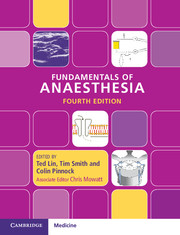Book contents
- Fundamentals of Anaesthesia
- Fundamentals of Anaesthesia
- Copyright page
- Dedication
- Contents
- Contributors
- Preface to the first edition
- Preface to the second edition
- Preface to the third edition
- Preface to the fourth edition
- Acknowledgements
- Abbreviations
- Section 1 Clinical anaesthesia
- Chapter 1 Preoperative management
- Chapter 2 Conduct of anaesthesia
- Chapter 3 Intraoperative management
- Chapter 4 Postoperative management
- Chapter 5 Special patient circumstances
- Chapter 6 The surgical insult
- Chapter 7 Regional anaesthesia
- Chapter 8 Principles of resuscitation
- Chapter 9 Major trauma
- Section 2 Physiology
- Section 3 Pharmacology
- Section 4 Physics and clinical measurement
- Index
- References
Chapter 7 - Regional anaesthesia
from Section 1 - Clinical anaesthesia
Published online by Cambridge University Press: 19 January 2017
- Fundamentals of Anaesthesia
- Fundamentals of Anaesthesia
- Copyright page
- Dedication
- Contents
- Contributors
- Preface to the first edition
- Preface to the second edition
- Preface to the third edition
- Preface to the fourth edition
- Acknowledgements
- Abbreviations
- Section 1 Clinical anaesthesia
- Chapter 1 Preoperative management
- Chapter 2 Conduct of anaesthesia
- Chapter 3 Intraoperative management
- Chapter 4 Postoperative management
- Chapter 5 Special patient circumstances
- Chapter 6 The surgical insult
- Chapter 7 Regional anaesthesia
- Chapter 8 Principles of resuscitation
- Chapter 9 Major trauma
- Section 2 Physiology
- Section 3 Pharmacology
- Section 4 Physics and clinical measurement
- Index
- References
Summary
Regional anaesthesia has its origins in 1884, 38 years after the discovery of general anaesthesia, when Carl Koller instilled a solution of cocaine into a patient’s eye and performed glaucoma surgery ‘under local’. This landmark discovery led to an explosion of interest in blocking nerve conduction as surgeons looked for less dangerous alternatives to the general anaesthetic techniques then available.
- Type
- Chapter
- Information
- Fundamentals of Anaesthesia , pp. 139 - 169Publisher: Cambridge University PressPrint publication year: 2016
References
References and further reading
- 1
- Cited by



